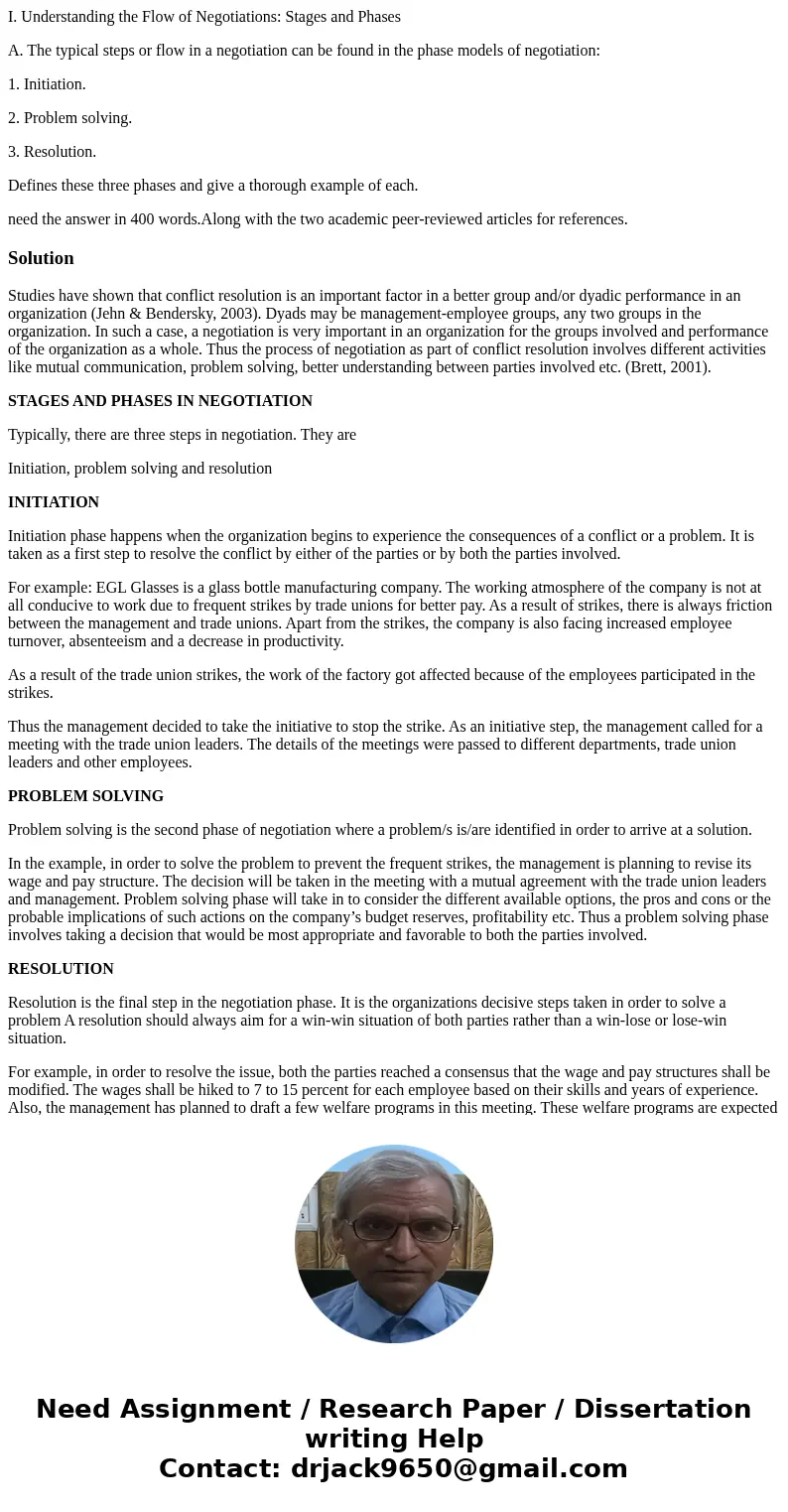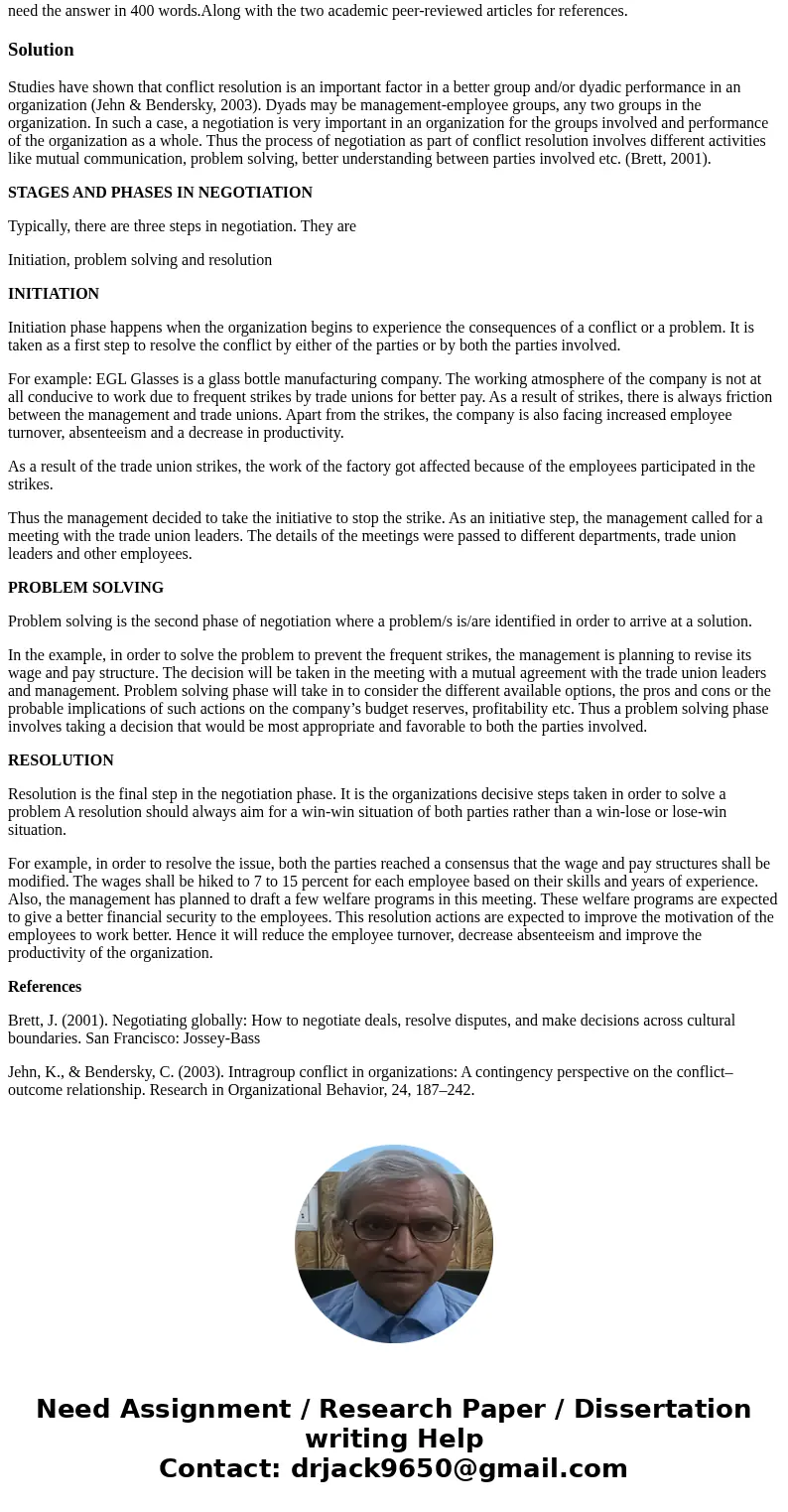I Understanding the Flow of Negotiations Stages and Phases A
I. Understanding the Flow of Negotiations: Stages and Phases
A. The typical steps or flow in a negotiation can be found in the phase models of negotiation:
1. Initiation.
2. Problem solving.
3. Resolution.
Defines these three phases and give a thorough example of each.
need the answer in 400 words.Along with the two academic peer-reviewed articles for references.
Solution
Studies have shown that conflict resolution is an important factor in a better group and/or dyadic performance in an organization (Jehn & Bendersky, 2003). Dyads may be management-employee groups, any two groups in the organization. In such a case, a negotiation is very important in an organization for the groups involved and performance of the organization as a whole. Thus the process of negotiation as part of conflict resolution involves different activities like mutual communication, problem solving, better understanding between parties involved etc. (Brett, 2001).
STAGES AND PHASES IN NEGOTIATION
Typically, there are three steps in negotiation. They are
Initiation, problem solving and resolution
INITIATION
Initiation phase happens when the organization begins to experience the consequences of a conflict or a problem. It is taken as a first step to resolve the conflict by either of the parties or by both the parties involved.
For example: EGL Glasses is a glass bottle manufacturing company. The working atmosphere of the company is not at all conducive to work due to frequent strikes by trade unions for better pay. As a result of strikes, there is always friction between the management and trade unions. Apart from the strikes, the company is also facing increased employee turnover, absenteeism and a decrease in productivity.
As a result of the trade union strikes, the work of the factory got affected because of the employees participated in the strikes.
Thus the management decided to take the initiative to stop the strike. As an initiative step, the management called for a meeting with the trade union leaders. The details of the meetings were passed to different departments, trade union leaders and other employees.
PROBLEM SOLVING
Problem solving is the second phase of negotiation where a problem/s is/are identified in order to arrive at a solution.
In the example, in order to solve the problem to prevent the frequent strikes, the management is planning to revise its wage and pay structure. The decision will be taken in the meeting with a mutual agreement with the trade union leaders and management. Problem solving phase will take in to consider the different available options, the pros and cons or the probable implications of such actions on the company’s budget reserves, profitability etc. Thus a problem solving phase involves taking a decision that would be most appropriate and favorable to both the parties involved.
RESOLUTION
Resolution is the final step in the negotiation phase. It is the organizations decisive steps taken in order to solve a problem A resolution should always aim for a win-win situation of both parties rather than a win-lose or lose-win situation.
For example, in order to resolve the issue, both the parties reached a consensus that the wage and pay structures shall be modified. The wages shall be hiked to 7 to 15 percent for each employee based on their skills and years of experience. Also, the management has planned to draft a few welfare programs in this meeting. These welfare programs are expected to give a better financial security to the employees. This resolution actions are expected to improve the motivation of the employees to work better. Hence it will reduce the employee turnover, decrease absenteeism and improve the productivity of the organization.
References
Brett, J. (2001). Negotiating globally: How to negotiate deals, resolve disputes, and make decisions across cultural boundaries. San Francisco: Jossey-Bass
Jehn, K., & Bendersky, C. (2003). Intragroup conflict in organizations: A contingency perspective on the conflict– outcome relationship. Research in Organizational Behavior, 24, 187–242.


 Homework Sourse
Homework Sourse